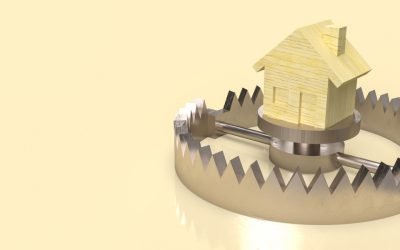A common issue faced by property investors, owners, and landlords is that of rising damp, but what causes rising damp in internal walls?
Rising damp occurs when moisture builds up inside a wall over time. This can cause damage to plasterwork, wood panelling, and other materials. The problem usually arises from poor drainage around windows and doors, or from condensation caused by cold draughts.
Rising damp is a common problem in homes with older foundations. The most common cause of rising damp is water leaking into the wall from outside the house. Water enters the wall through cracks in the exterior siding, around pipes, or under doors and windows. Although this is commonly thought of as an internal problem, it can happen in external walls as well.
As long as the water stays outside, it doesn’t cause any problems. But once it gets inside, it starts to dry out the wall and cause damage.
This damage can range from mildew growth to serious structural issues. It can even lead to mould growth, which can cause health problems.
If you notice any problems with your drain system or the rising damp, you should immediately contact a specialist. Today, finding a plumber in East London or other areas is easy.
An increased level of moisture in building structures, elements, and materials, a reduced or absent opportunity for natural or forced drying leads to a permanent or temporary rising damp in internal walls.
Signs of rising damp
The damage caused by rising damp includes mould growth and damage to wood floors, walls, ceilings, and furniture, and therefore has some easy to spot signs. Most people know about damp patches on walls at ground level, but there are additional signs to look out for.

Unpleasant smells. The intensity of smells in a room increases with increasing humidity. An increase in household smells may indicate an increase in humidity in the room atmosphere. A musty smell can signal the growth of mould, mildew, or rot.
Feeling damp. Indicates an increase in humidity and a violation of ventilation in the room.
Condensation, frost, and ice formation on cold surfaces. All of them signal extra moisture in the room and the presence of insufficient insulation of the outer contour of the building and possible leaks of warm air through the cracks.
Changes in colour, texture, and moisture of material surfaces. Warping, swelling, deformation, cracking, blistering, crumbling, flaking, discolouration, darkening, dark or coloured spots on the surfaces of materials may indicate high humidity in the room.
Biological destruction of wood. The rot and decay of wooden structures indicate the constant damaging effect of moisture, which creates optimal conditions for the growth and reproduction of microorganisms that destroy the tree.
Wet pipes. “Sweating” cold pipes are a sign of dampness in your home. The cold water significantly cools the pipe surfaces on which excess moisture condenses.
Hygrometer readings. An excess of more than 50% relative humidity in a home may indicate a humidity problem. At the same time, even a low level of humidity in the atmosphere of a house does not guarantee the absence of problems with excess humidity in structures or individual rooms (basements, attics, etc.).
If you suspect that your home may be suffering from rising damp, then you should call a professional immediately. They will inspect your property and determine whether you need to repair the issue before it gets worse.
The causes of rising damp in internal walls
Rising damp is caused by moisture in the ground being drawn up through the porous walls of a property. The most common cause of this is when there is inadequate or no waterproofing membrane present between the wall and the ground, allowing water to seep into the bricks and stone.
This can also be exacerbated by poor drainage around the property which doesn’t allow water to run away from buildings, as well as planting that’s too close to walls which prevents air circulation and stops moisture evaporating.
There are other factors to consider:
- Interstitial condensation. Porous building materials such as wood, concrete, and others contain a certain amount of moisture in the structure of the material.
- Trunk moisture. Moisture can enter the house in the form of rain, snow, or groundwater, water supply, and sewerage leaks, water storage tanks, seeping through leaks in moisture-insulating media.
- Capillary moisture. Capillary moisture enters the house through microscopic communicating pores of materials such as concrete, brick, and wood from the external humid environment in the absence of waterproofing layers or layers that rupture the capillaries.
- Moisture moving by airflow. Airflow through cracks in building structures or through open openings, windows, or doors is capable of transporting saturated water vapor from the street.
- Vapor transport of moisture through porous materials. Due to the pressure difference, water vapor can penetrate through porous materials such as aerated concrete or wood.
However, if the problem cannot be avoided in time, you should contact drain repair services. You should entrust the work to real professionals who will quickly and efficiently fix all problems. Do not try to make repair works by yourself, you can only make it worse and then the repair service will cost even more than before.
How Serious is Rising Damp
If rising damp is left untreated, it can become a serious problem for homeowners. It causes structural problems like rot and drywall damage, and it can lead to health issues like asthma and allergies.
Developing asthma can result in chest tightness, coughing fits, wheezing and having an asthma attack. If this continues over a long period of time, breathing difficulties can develop into chronic bronchitis, emphysema, or lung cancer.
Allergies can also occur due to the presence of mould spores in the air. Mold spores can cause allergic reactions in people who have been sensitized by previous exposure.
Rising damp can also cause other health problems, including:
- Skin irritation
- Headaches
- Eye irritation
- Asthma attacks
- Coughs
- Allergic reactions
- Fatigue
Rising damp can also affect the appearance of the interior of a house. The most common signs are:
- Water stains on ceilings and walls
- Puddles of standing water
- Moisture spots on floors
- Wet areas under furniture
- A musty odor
You should always keep an eye out for these symptoms and take action right away. Otherwise, the problem could get worse, and you might end up paying much more money for repairs.
How to treat rising damp on internal walls
The result of damp walls is no joke, so it’s important to get the problem addressed as soon as possible. Fortunately, there are some quick ways to prevent rising damp.
One of those ways is to keep your roof in good shape. A leaky roof can let rainwater get into your walls and ceilings.
You should also ensure extractor fans are fitted to any rooms that are likely to have high humidity levels, such as bathrooms, showers or laundry rooms.
Finally, you should check your foundation regularly. If you notice any cracks or holes, you should seal them immediately. These small leaks can cause big problems over time.
While these will help prevent problems, there are going to be times when professional damp treatments are required.
The most common solution is to inject a specialist chemical into the wall, which then creates a waterproof barrier.
Another option is to install an electrical Damp-Proof Course (DPC). This sends small electrical charges through the wall, which break down any moisture that is present.
Finally, you could also drill drainage holes into the base of your walls. These will allow any water that has accumulated to drain away, preventing it from causing further damage.
All of these options need to be done by a professional and can be expensive, but once done will ensure you don’t suffer the issue again.
Can you sell a house with rising damp?
Yes, you can sell a house with rising damp, but it will be more difficult to find a buyer, and you may have to sell at a lower price.
As rising damp is a serious problem that can cause structural damage to a property, most buyers will be wary of purchasing a property with this issue.
If you are selling your property, it is important to disclose the problem to potential buyers and be prepared to negotiate on price.
If you are buying a property, make sure you ask about the history of the property. You want to know if they’ve had any issues with rising damp before and if there are signs of it being present, make sure to negotiate either a lower price or for the matter to be addressed before you finalise the purchase.
Conclusion
Rising damp is a serious problem that can cause extensive damage to your property. If you suspect that you have rising damp, it is important to get it diagnosed and treated as soon as possible.
Rising damp can be difficult to identify, but there are some tell-tale signs that you can look out for. These include:
- Peeling or flaking paintwork
- Crumbling plasterwork
- Musty smells in the room/property
If you think you may have rising damp, it is best to contact a professional who will be able to carry out an assessment and advise on the best course of treatment.
- Rent-to-Rent Schemes: Hidden Dangers Lurk - July 6, 2024
- How to Sell Your House Fast in Kent - July 5, 2024
- 7 Tips to Sell Your House Fast - July 4, 2024


